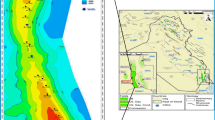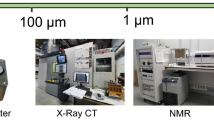Abstract
This paper presents the petrophysical evaluation of a gas reservoir from the Gulf of San Jorge basin, Argentina, by means of two-dimensional nuclear magnetic resonance (2D-NMR) maps and a geometric pore scale modeling of the NMR response of the wetting phase. The reservoir contains gas and irreducible water saturation at the top with a sharp transition into the water zone. The well has been logged with conventional tools such as gamma ray, neutron, density, and also the MRExplorerSM (MREXSM) to acquire the NMR data for determining the irreducible water saturation. Data from special core analysis, scanning electron microscopy, thin sections, and capillary pressure tests have also been acquired. The core-log evaluation shows a very good agreement between the laboratory and log field data, especially in terms of irreducible water saturation, porosity, and permeability, which was also modeled using the Timur–Coates equation for purposes of field delivery. The 2D-NMR maps as T1 vs. T2 apparent (T2app) and diffusivity vs. T2 intrinsic (T2int) from both hydrocarbon and water zone lead to characterize the clay-bound and capillary-bound water and the under-called porosity due to the low hydrogen index of the gas. We use a pore scale model to quantify the effect of pendular water on T2 distribution. The methodology is based on constructing physically representative model rocks numerically, which allows precise geometric description of pore space. Unlike many other approaches to pore-level modeling, this approach introduces no adjustable parameters and can be used to produce quantitative, a priori predictions of the rock macroscopic behavior.
Similar content being viewed by others
References
Thern, H., Chen, S.: Deterministic method for gas reservoir evaluation using dual wait-time NMR and density log data. SPE 56792, SPE-ATCE, Houston, 3–6 October 1999
Hursan, G., Chen, S., Murphy, E.: New NMR two-dimensional inversion of T1/T2app vs. T2app method for gas well petrophysical interpretation. Paper GGG, SPWLA 46th Annual Logging Symposium, 26–29 June 2005
Winkler, M., Freeman, J., Quint, E., Caputi M.: Evaluating tight gas reservoirs with NMR—the perception, the reality and how to make it work. Paper BB, SPWLA 47th Annual Logging Symposium, Veracruz, 4–7 June 2006
Gladkikh, M., Jacobi, D., Mendez, F.: Pore geometric modeling for petrophysical interpretation of downhole formation evaluation data. Water Resour. Res. 43, W12S08. doi:10.1029/2006WR005688
Brownstein, K.R., Tarr, C.E.: Importance of classical diffusion in NMR studies of water in biological cells. Phys. Rev., A. 19(6), 2446–2453 (1979)
Bryant, S.L., Pallatt, N.: Predicting formation factor and resistivity index in simple sandstones. J. Pet. Sci. Eng. 15, 169–179 (1996)
Bryant, S.L., Raikes, S.: Prediction of elastic-wave velocities in sandstones using structural models. Geophysics 60(2), 437–446 (1995)
Bryant, S.L., Blunt, M.: Prediction of relative permeability in simple porous media. Phys. Rev., A. 46, 2004–2011 (1992)
Bryant, S.L., Mellor, D.W., Cade, C.A.: Physically representative network models of transport in porous media. AIChE J. 39, 387–396 (1993)
Gladkikh, M.: A Priori prediction of macroscopic properties of sedimentary rocks containing two immiscible fluids. Ph.D Dissertation Thesis, University of Texas at Austin, Austin, TX, USA (2005)
Gladkikh, M., Bryant, S.L.: Prediction of imbibition in unconsolidated granular materials. J. Coll. Int. Sci. 288(2), 526–539 (2005)
Mason, G.J., Mellor, D.W.: Simulation of drainage and imbibition in a random packing of equal spheres. J. Coll. Int. Sci. 176, 214–225 (1995)
Mason, G.J.: A model of the pore space in a random packing of equal spheres. J. Coll. Int. Sci. 35, 279–287 (1971)
Thompson, K.E.: Fast and robust Delaunay tessellation in periodic domains. Int. J. Numer. Methods Eng. 55(11), 1345–1366 (2002)
Bryant, S.L., Johnson, A.S.: Wetting phase connectivity and irreducible saturation in simple granular media. J. Coll. Int. Sci. 263(2), 572–579 (2003)
Author information
Authors and Affiliations
Corresponding author
Rights and permissions
About this article
Cite this article
Romero, P., Gladkikh, M. & Azpiroz, G. Applications of 2D-NMR maps and geometric pore scale modeling for petrophysical evaluation of a gas well. Comput Geosci 13, 171–180 (2009). https://doi.org/10.1007/s10596-008-9098-6
Received:
Accepted:
Published:
Issue Date:
DOI: https://doi.org/10.1007/s10596-008-9098-6




